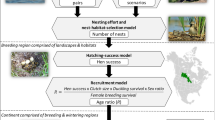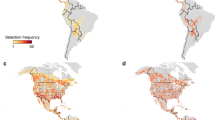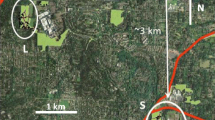Abstract
Although stopover habitats are used by many species as refuelling stations during migration and can be critical for survival and successful reproduction, they are rarely incorporated in year-round population models and conservation strategies. We incorporate stopover habitat into a density-dependent population model and then use this model to examine how optimizing one-time land purchase strategies for a migratory population is influenced by variation in the quality and the strength of density-dependence in a stopover habitat used for both fall and spring migration. As the strength of the density-dependence in the stopover habitat increases, the optimal amount of stopover habitat purchased increases while the amount of habitat during the stationary periods of the annual cycle (breeding and wintering) decreases. Any change in the cost of purchasing stopover habitat affects investment strategies in all three periods of the annual cycle. When the quality of the stopover habitat is high, the optimal strategy is to invest in low-quality habitat during breeding and wintering and when the stopover habitat quality is low, the optimal strategy switches to investing in high-quality habitat during the stationary periods. We apply this model to a threatened warbler population and demonstrate how purchase decisions to conserve stopover habitat that are not coordinated with conservation actions on the breeding and wintering grounds can potentially result in a lower population carrying-capacity compared to considering habitat in all three periods of the annual cycle simultaneously. Our model provides potential guidelines for developing conservation strategies for animals that rely on refueling habitats between the stationary breeding and non-breeding periods of the migratory cycle.


Similar content being viewed by others
References
Atienza JC, Pinilla J, Justribo JH (2001) Migration and conservation of the aquatic warbler Acrocephalus paludicola in Spain. Ardeola 48:197–208
Bairlein F (1985) Body weights and fat deposition of Palaearctic passerine migrants in the central Sahara. Oecologia 66:141–146
Basili GD, Temple SA (1999) Dickcissels and crop damage in Venezuela: defining the problem with ecological models. Ecology 9:732–739
Bearhop S, Hilton GM, Votier SC, Waldron S (2004) Stable isotope ratios indicate that body condition in migrating passerines is influenced by winter habitat. Proc R Soc Lond B Biol Sci 271:S215–S218
Bêty J, Gauthier G, Giroux J-F (2003) Body condition, migration and timing of reproduction in Snow Geese, a test of the condition-dependent model of optimal clutch size. Am Nat 162:110–121
Committee on the Status of Endangered Wildlife in Canada (2000) COSEWIC assessment and update status report on the Hooded warbler Wilsonia citrina in Canada. Committee on the Status of Endangered Wildlife in Canada, Ottawa
Dankel DJ, Skagen DW, Ulltang O (2008) Fisheries management in practice: review of 13 commercially important fish stocks. Rev Fish Biol Fish 18:201–233
Delingat J, Dierschke V, Schmaljohann H, Mendel B, Bairlein F (2006) Daily stopovers as optimal migration strategy in a long-distance migrating passerine: the northern wheatear Oenanthe oenanthe. Ardea 94:593–605
Drent R, Both C, Green M, Madsen J, Piersma T (2003) Pay-offs and penalties of competing migratory schedules. Oikos 103:274–292
Fretwell SD (1972) Populations in a seasonal environment. Princeton University Press, Princeton
Haramis GM, Nichols JB, Pollock KH, Hines JE (1986) The relationship between body mass and survival of wintering canvasbacks. Auk 103:506–514
Heredia B, Rose L, Painter M (1996) Globally threatened birds in Europe, action plans. Council of Europe Publishing, Strasbourg
Kelly JF, DeLay LS, Finch DM (2002) Density-dependent mass gain by wilson’s warblers during stopover. Auk 119:210–213
Klaassen M, Bauer S, Madsen J, Possingham HP (2008) Optimal management of a goose flyway: migrant management at minimum cost. J Appl Ecol 45:1446–1452
Langin KM, Marra PP, Németh Z, Moore FR, Kyser TK, Ratcliffe LM (2009) Breeding latitude and timing of spring migration in songbirds crossing the Gulf of Mexico. J Avian Biol 40:309–316
Lehnen SE, Krementz DG (2005) Turnover rates of fall-migrating pectoral sandpipers in the lower mississippi alluvial valley. J Wildl Manage 69:671–680
Levy DA, Cadenhead AD (1995) Selective tidal stream transport of adult sockeye salmon (Oncorhynchus nerka) in the Fraser River estuary. Can J Fish Aquat Sci 52:1–12
Mackenzie SA, Friis CA (2006) Long Point bird observatory 2005 field operations report. Long Point bird observatory, Long Point (Port Rowan)
Migratory Bird Conservation Commission (2008) In: 2007 Annual Report—Migratory Bird Conservation Commission. U.S. Fish and Wildlife Service, Arlington, pp 1–50
Migratory Bird Conservation Commission (2009) In: 2008 Annual Report—Migratory Bird Conservation Commission. U.S. Fish and Wildlife Service, Arlington, pp 1–53
Norris DR (2005) Carry-over effects and habitat quality in migratory populations. Oikos 109:178–186
Norris DR, Taylor CM (2006) Predicting the consequences of carry-over effects in migratory populations. Biol Lett 2:148–151
Norris DR, Marra PP, Kyser TK, Sherry TW, Ratcliffe LM (2004) Tropical winter habitat limits reproductive success on the temperate breeding grounds in a migratory bird. Proc R Soc B Biol Sci 271:59–64
Ogden LJ, Stutchbury BJ (1994) Hooded Warbler (Wilsonia citrina). In: Poole A, Gill F (eds) The birds of North America. Academy of Natural Sciences/American Ornithologists’ Union, Philadelphia/Washington D.C.
Pfister C, Kasprzyk MJ, Harrington BA (1998) Body fat levels and annual return in migrating semipalmated sandpipers. Auk 115:904–915
Robbins CS, Fitzpatrick JW, Hamel PB (1992) A warbler in trouble: Dendroica cerulea. In: Hagan JM, Johnston DW (eds) Ecology and conservation of neotropical migrant landbirds. Smithsonian Institution Press, Washington D.C., pp 549–562
Russell RW, Carpenter FL, Hixon MA, Paton DC (1992) The impact of variation in stopover habitat quality on migrant rufuous hummingbirds. Conserv Biol 8:483–490
Sandberg R, Moore FR (1996) Fat stores and arrival on the breeding grounds: reproductive consequences for passerine migrants. Oikos 77:577–581
Schaffer N, Walther BA, Gutteridge K, Rahbek C (2006) The African migration and wintering grounds of the aquatic warbler Acrocephalus paludicola. Bird Conserv Int 16:33–56
Schaub M, Jenni L (2001) Variation of fuelling rates among sites, days and individuals in migrating passerine birds. Funct Ecol 15:584–594
Schaub M, Jenni L, Bairlein F (2008) Fuel stores, fuel accumulation, and the decision to depart from a migration stopover site. Behav Ecol 19:657–666
Sheehy J, Taylor C, Norris DR (2010) Optimal conservation planning for migratory animals: integrating demographic information across seasons. Conserv Lett 3:192–202
Shimazaki H, Tamura M, Higuchi H (2004) Migration routes and important stopover sites of endangered oriental white storks (Ciconia boyciana) as revealed by satellite tracking. Mem Natl Inst Polar Res 58:162–178
Smith RJ, Moore FR (2003) Arrival fat and reproductive performance in a long-distance passerine migrant. Oecologia 134:325–331
Spear LB, Ainley DG (1999) Migration routes of sooty shearwaters in the pacific ocean. Condor 101:205–218
Sutherland WJ (1996) Predicting the consequences of habitat loss for migratory populations. Proc R Soc B Biol Sci 263:1325–1327
Acknowledgments
DRN was supported by grants from the Natural Sciences and Engineering Research Council of Canada, and an Early Researcher Award from the Ontario Ministry of Innovation and Training. Kevin McCann provided valuable comments on earlier drafts of the manuscript.
Author information
Authors and Affiliations
Corresponding author
Additional information
Communicated by F. Bairlein.
Electronic supplementary material
Below is the link to the electronic supplementary material.
Rights and permissions
About this article
Cite this article
Sheehy, J., Taylor, C.M. & Norris, D.R. The importance of stopover habitat for developing effective conservation strategies for migratory animals. J Ornithol 152 (Suppl 1), 161–168 (2011). https://doi.org/10.1007/s10336-011-0682-5
Received:
Revised:
Accepted:
Published:
Issue Date:
DOI: https://doi.org/10.1007/s10336-011-0682-5




